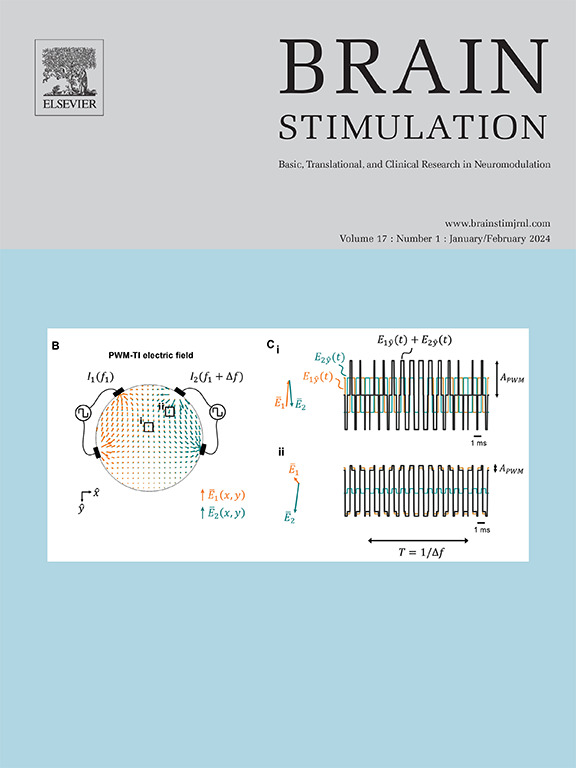Transcranial direct current stimulation plus cognitive training for cognitive symptoms in patients with post-acute sequelae of SARS-CoV-2 infection: A randomized, double-blind, sham-controlled trial
IF 8.4
1区 医学
Q1 CLINICAL NEUROLOGY
引用次数: 0
Abstract
Background
Post-acute sequelae of SARS-CoV-2 infection (PASC) is characterized by persistent cognitive deficits alongside anxiety and depression symptoms that adversely affect quality of life. Cognitive training (CT) programs and non-invasive neuromodulation, specifically transcranial direct current stimulation (tDCS), have each shown promise for alleviating similar deficits in non-clinical populations. However, their combined efficacy has not yet been evaluated in PASC patients. Therefore, this study aimed to determine whether the combination of CT and tDCS produces benefits for cognitive and mood-related symptoms in individuals with PASC.
Methods
We conducted a double-blind, randomized, sham-controlled clinical trial in adults aged 18–75 with confirmed SARS-CoV-2 infection within the past six months and persisting cognitive complaints. They were randomized to a 4-week in-person intervention of 20 weekday sessions of either active (2 mA anodal-left, cathodal-right prefrontal stimulation) or sham tDCS paired with an app-based CT program. Primary outcomes were six standardized neuropsychological tests assessing verbal memory, working memory, executive functioning, attention, and language, administered at baseline and immediately post-intervention. As secondary outcomes, we assessed changes in depression and anxiety symptoms over the treatment period.
Results
Sixty participants (mean age 43.8 ± 13.2 years, 71.7 % women) were randomized to active tDCS + CT or sham tDCS + CT groups, and 52 finished the trial. Compared to sham, tDCS + CT resulted in significantly greater improvement in tests evaluating inhibitory control (effect size [ES] = 0.07, 95 % CI 0 to 0.23, p = 0.046), processing speed (ES = 0.08, 95 % CI 0 to 0.25, p = 0.034), and divided attention (ES = 0.08, 95 % CI 0 to 0.24, p = 0.039), but not in tests evaluating other domains. Both groups improved similarly in depression and anxiety symptoms. Participant's and rater's active guess rates did not differ between groups (ps > 0.20).
Conclusion
An intervention with prefrontal targeted tDCS + CT in patients with PASC with cognitive complaints might be effective in improving attention, processing speed and inhibitory control, although further studies are warranted to prospectively confirm these findings.
Clinicaltrials.gov
NCT05389592.
经颅直流电刺激加认知训练对SARS-CoV-2感染急性后后遗症患者认知症状的影响:一项随机、双盲、假对照试验
SARS-CoV-2感染急性后后遗症(PASC)的特征是持续的认知缺陷,同时伴有焦虑和抑郁症状,对生活质量产生不利影响。认知训练(CT)项目和非侵入性神经调节,特别是经颅直流电刺激(tDCS),都显示出减轻非临床人群类似缺陷的希望。然而,它们在PASC患者中的联合疗效尚未得到评估。因此,本研究旨在确定CT和tDCS联合治疗PASC患者的认知和情绪相关症状是否有益。方法采用双盲、随机、假对照的临床试验方法,对18-75岁在过去6个月内确诊为SARS-CoV-2感染并持续存在认知症状的成年人进行研究。他们被随机分配到为期4周的20个工作日的亲自干预中,其中包括积极的(2 mA的正负左、正负右前额叶刺激)或假性tDCS与基于应用程序的CT程序配对。主要结果是六项标准化的神经心理测试,评估语言记忆、工作记忆、执行功能、注意力和语言,在基线和干预后立即进行。作为次要结果,我们评估了治疗期间抑郁和焦虑症状的变化。结果60名参与者(平均年龄43.8±13.2岁,71.7%为女性)被随机分为活动性tDCS + CT组和假性tDCS + CT组,52名参与者完成了试验。与假手术相比,tDCS + CT在评估抑制控制的测试(效应值[ES] = 0.07, 95% CI 0 ~ 0.23, p = 0.046)、处理速度(ES = 0.08, 95% CI 0 ~ 0.25, p = 0.034)和分散注意力(ES = 0.08, 95% CI 0 ~ 0.24, p = 0.039)方面显著改善,但在评估其他领域的测试中无显著改善。两组在抑郁和焦虑症状上的改善相似。参与者和评价者的积极猜测率在两组之间没有差异(ps > 0.20)。结论对伴有认知障碍的PASC患者进行前额叶靶向tDCS + CT干预可能有效改善注意力、处理速度和抑制控制,但需要进一步的研究来前瞻性地证实这些发现。
本文章由计算机程序翻译,如有差异,请以英文原文为准。
求助全文
约1分钟内获得全文
求助全文
来源期刊

Brain Stimulation
医学-临床神经学
CiteScore
13.10
自引率
9.10%
发文量
256
审稿时长
72 days
期刊介绍:
Brain Stimulation publishes on the entire field of brain stimulation, including noninvasive and invasive techniques and technologies that alter brain function through the use of electrical, magnetic, radiowave, or focally targeted pharmacologic stimulation.
Brain Stimulation aims to be the premier journal for publication of original research in the field of neuromodulation. The journal includes: a) Original articles; b) Short Communications; c) Invited and original reviews; d) Technology and methodological perspectives (reviews of new devices, description of new methods, etc.); and e) Letters to the Editor. Special issues of the journal will be considered based on scientific merit.
 求助内容:
求助内容: 应助结果提醒方式:
应助结果提醒方式:


